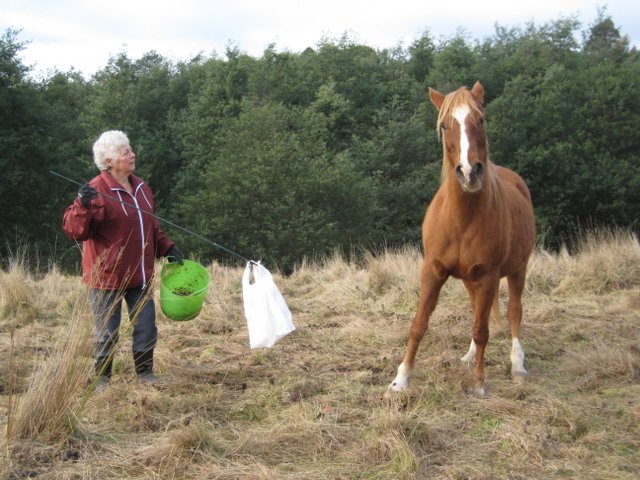By Cynthia Cooper
Cynthia regularly gets call for help from people having problems with their horses, and where they are issues that affect many people, she shares the solutions on her blog. This is a question that is asked regularly.
Question – Being Aggressive over feed
My horse kicks out when I feed him, not nastily but with excitement to get his dinner. He often double-barrels when his head is already in the feed-bin, and sometimes he swings around and turns his rear end to me. He is a 16.1 Thoroughbred ex-racehorse, and lives out. He’s rugged, fed in the paddock and his mate is fed further away.
He gets his dinner first, or he’ll eat the other horse’s dinner, and he follows me very close while I’m carrying it in. I don’t want him to think I’m scared of him (I’m not) but it’s a bit intimidating to have him hanging over me and then claiming his dinner so strongly.
He gets a feed most nights after I ride, and hay to eat every day and he has grass to graze, so I don’t think he’s really hungry, just possessive about his food. How can I teach him to be more patient and respectful?
Thank you.
Hayley, NSW.
Answer – Cynthia Cooper
As he’s obviously the alpha horse by claiming the feed before the other horse, showing excitement/dominance over feed is how he’s learned to respond due to reinforcement from the other horse and you both moving away.
At 16.1 he is quite large, and though you are looking after him well he may not be getting enough nutrition in his diet, particularly considering he is a Thoroughbred and being worked most days. Thoroughbreds tend to have a higher nutrient requirement, and if the pasture is poor, hay is of insufficient amount, or poor in quality, and/or if he’s carrying a worm burden, he may not be getting enough nutrition and this is making him greedy and over anxious when you hard feed him.
Preferably, free choice hay should be available all day to keep your horse feeling full, which should keep him less focused on feed time. It will also keep weight on him without needing lots of high-energy food which you then have to burn off when you ride.
However his assertive behaviour does need to be addressed, as you could end up getting hurt. Changing the routine and how you do things may help break his current habits, while teaching him some new ground rules to develop better, safer behaviour.
I would suggest first worming the horses if they haven’t been wormed in the past 12 weeks, then provide hay to eat all day as especially in winter the grass quality can be poor.
Even with grass in the paddock, a thoroughbred will need around 8-10kg of grass hay (1/3-1/2 bale) per day to meet its roughage requirements. This amount of lucerne hay would provide too much protein and could make him even more excitable. To make hay last throughout the day, use a ‘Slowfeeder’ type of haynet which has smaller holes so it replicates grazing.
When it comes to bucket feeding, have a solid barrier between you and your horse such as a gate or fence in case he gets anxious about the new routine during the initial re-training stage. Carry a stick with a plastic bag tied on the end (it can even be a bamboo garden stake or dressage whip) to claim your space and ownership of the feed.
While holding the bucket on your side of the gate, ask your horse to backup away from the gate by waving the stick with bag rythmically at chest height until he moves back. If he isn’t used to seeing a stick and bag, he may not need much pressure to move so use a little as possible, but as much as necessary to get him to maintain a couple of metres from the gate. When he has stood quietly for a few seconds and has his ears forward attentively, invite him to the feed and give him a handful.
 Be patient, as this may take a few minutes. Your horse may get cross or demanding, but don’t let him move forward – just keep him backed up and away from the gate using a rhythmic waving pressure with the stick until he stops and waits for your invitation.
Be patient, as this may take a few minutes. Your horse may get cross or demanding, but don’t let him move forward – just keep him backed up and away from the gate using a rhythmic waving pressure with the stick until he stops and waits for your invitation.
When he is backing up nicely and coming forward only when asked, go through the gate and walk to the feed bin while waving the stick/bag to keep him at the distance of the extended stick or further. Put the feed in his bin and if he comes forward before you ask, back him up again and wait for his ears to come up. Then invite him forward to eat.
This assertiveness from you should be enough to discourage him from kicking out, but if he does, immediately send him away from the feed with the stick/bag and re-do the exercise of asking him to wait with ears up before coming back to eat.
You could go a step further and give him lots of small feeds during the day while you are re-training him, and eventually you will be able to replace the stick with your extended arm waving at him to send him back (keep the stick handy in case you need it though). You can also tell him to ‘backup’ each time so ultimately, he will do that on voice command.
Be patient and persistent and he will soon see you as a leader, not just another herd member to send away!
Cynthia

